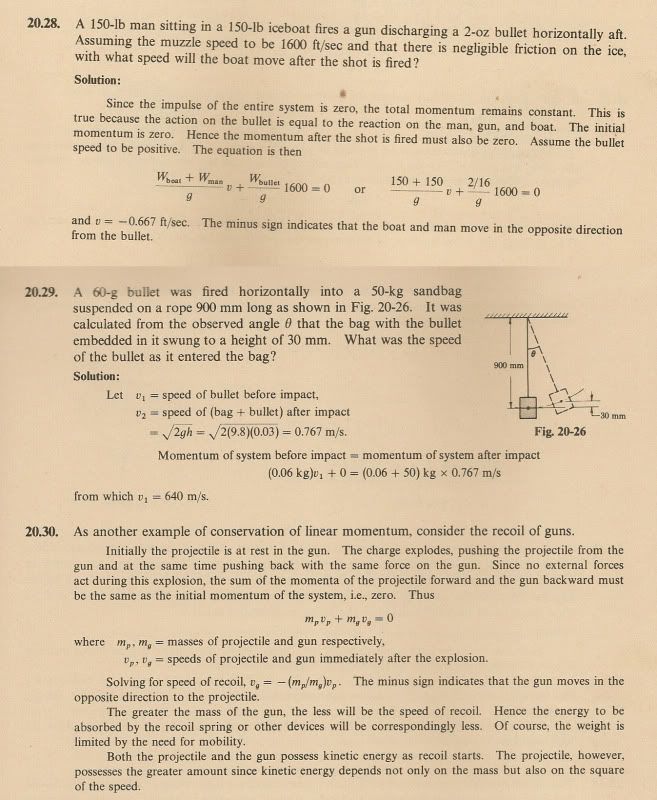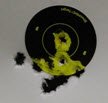Math behind the functioning of a 1911 from some previous threads, if anyone is interested.
If anyone is really interested, you can use Newton’s stuff from 400 years ago to understand how your gun works. We used it to get us to the moon back in the 60’s, we use it on the rockets and guns we’re designing today. If you don’t care to know, don’t worry about it, keep believing whatever makes you happy! No big deal.
For example, how long does your bullet remain in your gun barrel, and what kind of acceleration does the bullet experience?
What kind of acceleration does your slide experience, and how fast is it moving when the bullet exits? How far has the slide moved rearward when the bullet exits?
This kind of stuff is REAL important if you’re designing things like rocket mechanisms or artillery fuses or proximity detonators.
Not real easy to effectively transmit mathematical concepts in a forum format, but we can try. I’m going to ignore the contribution of the unburned powder and gases exiting the barrel with the bullet.
We’ll call the starting position of the bullet the zero of our coordinate system, so X(initial) = 0. We’ll abbreviate it as Xi cause I’m lazy. That means Xi = 0.
V(initial) is the starting velocity. We’ll call that Vi. For a bullet in a gun, it’s initial velocity is 0. So Vi = 0.
We’ll call the last position we consider, the end of the barrel, X(final). I’ll abbreviate that as Xf.
T = time in seconds.
T**2 means “T raised to the second power” or "T squared" or “T x T”.
X = position in inches.
V = velocity in feet per second.
A = acceleration in feet per second squared (fps**2).
The basic motion equation in terms of time is:
Xf = Xi + V x T + (A x T**2) / 2
If you want more on this basic motion equation, you can go here:
http://en.wikipedia.org/wiki/Equations_of_motion
Introductory calculus teaches us that the first derivative of position is velocity, and the first derivative of velocity and the second derivative of position is acceleration (I’m not going into calculus for you).
So Velocity = Vi + Acceleration x Time, or
Vf = Vi + A x T
We’ll look at a typical .45 caliber 1911. First thing we have to do is get everything into common units.
Bullet weight = 230 grains = 230/7000 pounds = .033 pounds = .001025 slugs (slug is mass unit in english system).
Barrel length = 5 inches = 5/12 feet = .417 feet
Bullet velocity when it exits the barrel at 5 inches = 830 feet per second.
Now we just use the basic motion equation:
Xf = Xi + Vi x T + (A x T**2) / 2
Put in our 1911 values that we know:
.417 = 0 + 0 x T + (A x T**2) / 2 or
.417 = (A x T**2) / 2 (NOTE – This will be EQ1)
Notice that we have 2 unknowns (A and T) but so far only one equation. From basic algebra we know that we need as many equations as unknowns if we hope to solve them.
This is where we use the rest of the stuff we know and the velocity equation:
Vf = Vi + (A x T)
We know Vf (Velocity final) is 830 fps. We know Vi (Velocity initial) is 0, so
830 = 0 + (A x T)
Since we loved algebra, we solve for A in the above equation and find
A = 830 / T (NOTE – This will be EQ2)
Now we can cleverly plug the above relationship back into our basic motion equation EQ1, replacing A with 830 / T.
.417 = (830/T) x (T**2) / 2
Simplifying this (basic algebra again) gives
.417 = 415 x T
Now we solve for T:
T = .417/415 = .0010048 seconds
In other words, T is right at 1/1000 of a second.
Since we now know T, we can easily solve for A from EQ2:
A = 830/ T = 830 / .001 = 830,000 feet per second squared.
Acceleration due to gravity = 32.2 fps**2, so our bullet is experiencing:
830,000 / 32.2 = 25776.4 G’s as it goes down the barrel.
Kind of important to know if you want to hang some electronics on your bullet. They better be able to handle more than 25,000 G’s.
How much force is the locked together barrel/slide seeing, and how fast is it accelerating?
We know that the force from the bullet equals its mass times acceleration, and we know that for every force there is an equal and opposite reaction (that Newton stuff again).
So the force delivered to the locked together barrel/slide from the bullet is:
F = M x A
F = mass of bullet x acceleration of bullet
F = .001025 x 830,000 = 851 pounds
How fast will 851 pounds accelerate the barrel/slide?
F = M x A = 851
Algebra again:
A = F / M = 851 / M
I’m going to say 1.5 pounds for the slide and .5 pounds for the barrel, mass would be 2/32.2 = .062 slugs.
So the acceleration of the slide is:
A = 851 / .062 = 13695 feet per second squared.
13,695 / 32.2 = 425.31 G's
Now we know the acceleration, so how fast is the slide moving when the bullet exits the barrel?
We know the bullet is in the barrel for .001 seconds, and once it leaves the barrel there is no more reaction with the gun. So the slide/barrel acceleration is applied for .001 seconds.
V = A x T = 13695 x .001 = 13.695 feet per second.
The slide is moving rearward at 13.7 feet per second when the bullet leaves the barrel.
How far has the slide moved when the bullet leaves the barrel?
Again we use the basic motion equation. Now that we know the acceleration and time, we can find the distance the slide moves:
Xf = Xi + Vi x T + (A x T**2) / 2
Xf = 0 + 0 x .001 + (13695 x .001**2) / 2
Xf = .0068475 feet = .082 inches, or just over 80 thousands of an inch.
You’ll find that with your 1911 slide .082 inches retracted, the barrel and slide will still be locked together. John Browning did all the stuff I did above over 100 years ago (once smokeless powder was invented so everything didn't get gummed up) when he started designing machine guns and semi-automatic pistols.
Recap:
Bullet velocity at barrel exit: 830 fps
Time bullet is in barrel: .001 second
Bullet acceleration while in barrel: 830,000 fps**2, or just over 25,000 G’s.
Slide acceleration while bullet is in barrel: 13,695 fps**2 or just over 425 G's
Slide velocity when bullet exits: 13.7 fps
Distance barrel/slide moves while bullet is in it: .082 inches
Note: The slide is accelerated ONLY while the bullet is in the barrel, so it’s only accelerated for .001 seconds. That’s why GLOOB kept trying to tell you that you couldn’t possibly apply over 850 pounds of force to the barrel to accelerate the slide as fast as the bullet does. You can see where the recoil spring force (16 or 18 pounds or so) is pretty irrelevent while the bullet is accelerating.
Notice that NOWHERE above does bullet/barrel friction come into play. If your 1911 has 10 pounds of barrel friction and a 230 grain bullet exits at 830 fps, it will experience the forces and timing above. If it has 1,000,000 pounds of barrel friction and a 230 grain bullet exits at 830 feet per second, it will also experience the exact same forces and timing above. Chamber pressure will have to be higher and your barrel and slide better be a LOT stronger, but the massive bullet drag will have NO effect on recoil, slide velocity, or slide position because it’s an internal force.
All of the stuff above is freshman year engineering Calculus 1, Physics, and Statics. No way anyone is going to explain it on an internet forum to anyone who does not have the fundamental background to understand it. I can see where it aggravates some people who understand trying to explain it!
Since we know the slide velocity, slide mass, barrel mass, recoil spring rate, and location where the slide unlocks, we could go on to calculate the slide velocity when it unlocks, the barrel velocity when it hits it's hard stop, the slide velocity when it hits it's hard stop in recoil, the time it takes to reach full recoil, and how long it will take to return to battery. We ignored the contribution of the recoil spring, hammer spring, unburnt powder, and gases exiting the barrel. Feel free to add them into the calculations if you feel the need.


